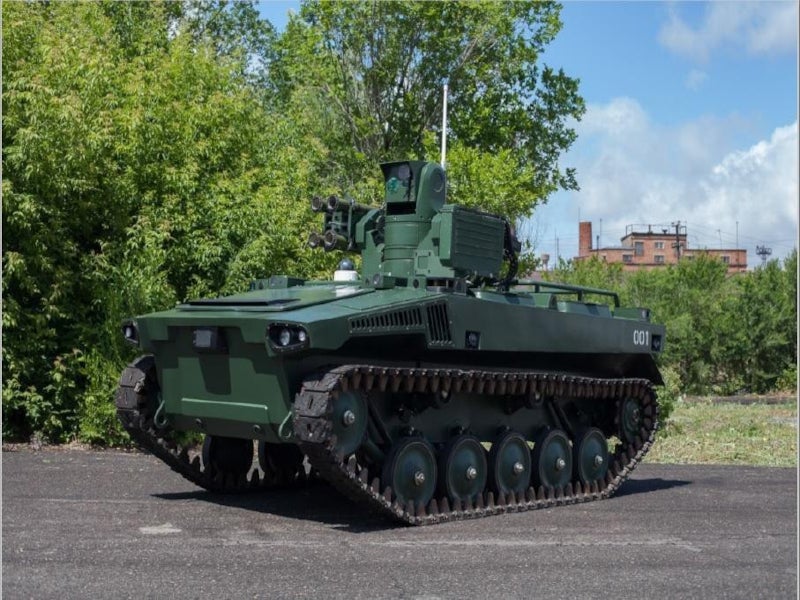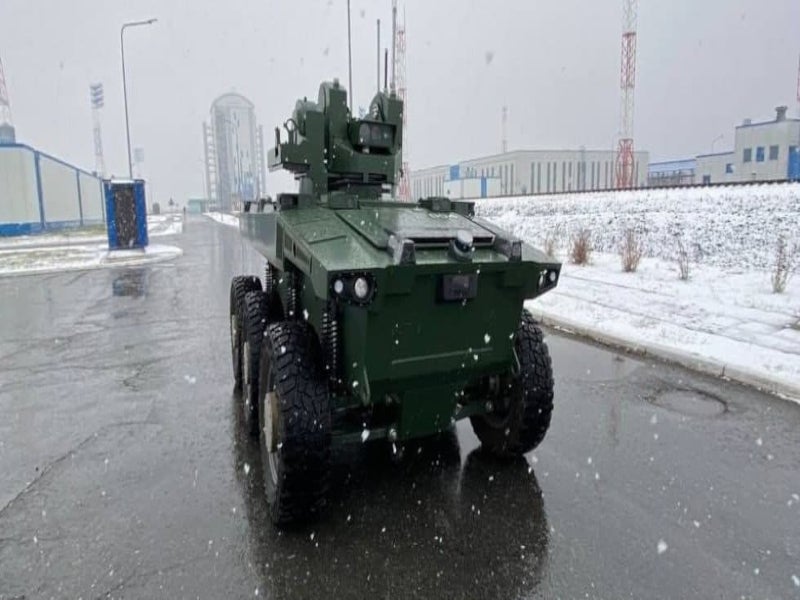Marker is an anti-tank robotic unmanned ground vehicle (UGV) developed by Androidnaya Tekhnika, a robotics company based in Russia, to provide reconnaissance and destroy enemy targets.
Androidnaya Tekhnika was commissioned by Russian research and development organisation Advanced Research Foundation to develop the Marker UGV. Work on the platform’s development began in March 2018. Five autonomous robotic platforms were developed within the project framework, two of which were tracked and three of which were wheeled.
Androidnaya Tekhnika was assisted by Advanced Research Foundation’s National Center for the Development of Technologies and Basic Elements of Robotics. State Research Institute of Aviation Systems (GosNIIAS), NKB VS, FGUP Research Institute Kvant, and FGAO EE SFU were the project’s co-developers.
Marker anti-tank robotic UGV development and testing
Shooting tests for the Marker robotic platform took place at a training ground of the Central Military District in Chelyabinsk, Russia, in August 2019. The platform successfully tracked targets autonomously and defeated them in the tests.
The project was implemented in three stages. The results of the first stage were demonstrated at the Magnitogorsk test site for robotic systems and complexes (MIP RSK) in October 2019. In the second stage, the platform undercarriage was designed and two wheeled platforms were assembled.
In August 2020, two Marker robotic platforms were displayed at the Army-2020 International Military-Technical Forum. One platform was on a static display to provide a closer look at its details, while the other was on a dynamic display and demonstrated elements of autonomous movement.
Tests to develop the Marker platform’s key technologies were carried out at the Vostochny launch site in October 2021.
In December 2021, a group of four platforms successfully passed the tests to move through a designated route and reach the destination in the Chelyabinsk region as part of acceptance testing. Androidnaya Tekhnika successfully completed its work on the Marker robotic platform project in January 2022.
In February 2023, four Marker robots were deployed in Russia’s special operation zone in Ukraine.
Marker anti-tank robot design and features
The Marker robotic platform weighs 3t and is designed to offer technical vision, communication, navigation, autonomous movement, and group control. It derives autonomous capabilities from a modular multi-spectral vision system, which uses neural network algorithms for data processing.
The vehicle can identify various types of intruders, including unauthorised personnel, unmanned aerial vehicles (UAVs), and motor vehicles. It uses electronic pulses and suicide drones to combat incoming hostile UAVs. The UGV uses radio electronic jamming to disrupt drone signals and neutralise them.
The Marker platform was developed to recognise objects using artificial intelligence technologies. It can be used to conduct patrol activities autonomously in dedicated security routes for ground-based space infrastructure facilities, as well as recognise security perimeter violators and intercept them.
In addition, the UGV’s deep neural network technology is expected to continuously improve its decision-making abilities.
Situational awareness of the Marker anti-tank robot
The Marker robotic platform can acquire complete situational awareness of the surrounding area up to more than 100m. This allows the operator to modify its movement in a timely manner without direct intervention.
Details of the Marker anti-tank UGV’s payload
Marker is an advanced autonomous multi-functional ground-based robotic complex platform equipped with a unified payload module and a UAV cluster launch module.
The tracked platform’s payload module is equipped with opto-electronic instruments and six independent rotation axes.
The module can support two types of payloads, which can each be used independently. Marker has a rotatable combat module that can turn 540° in a second, improving its speed and accuracy.
Marker anti-tank robot variants
Marker has been developed in combat and reconnaissance variants. The combat variant can be equipped with anti-tank missile systems, coaxial heavy machine guns, grenade launchers and other weapons. Its control system features an electronic catalogue containing images of targets in both visible and infrared ranges, which helps the system automatically determine the equipment of adversarial forces.
The reconnaissance variant connects to the robot through a cable, removing the need for a battery. Its control system can remain unaffected in electronic warfare.






